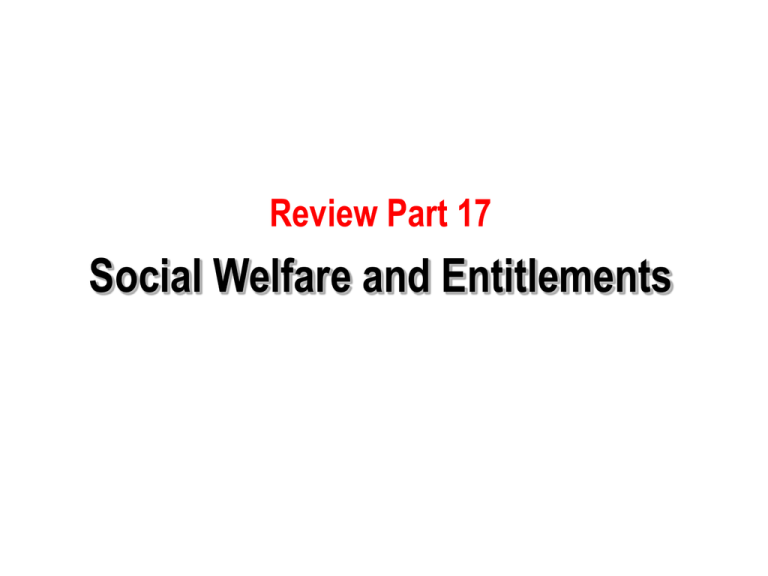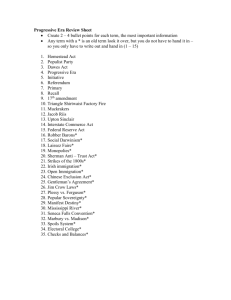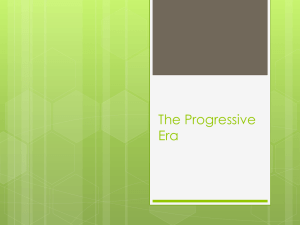No Slide Title - My Teacher Pages
advertisement

Review Part 17 Social Welfare and Entitlements 1) Which of the following is true about a classbased society? a. Disparity in the distribution of income and wealth b. Narrowing of the gap between the wealthy class and the middle class c. Increase in what the government determines to be an austere standard of living d. Reduction of the culture of poverty in the United States e. Move toward workfare rather than welfare 1) Which of the following is true about a classbased society? a. Disparity in the distribution of income and wealth b. Narrowing of the gap between the wealthy class and the middle class c. Increase in what the government determines to be an austere standard of living d. Reduction of the culture of poverty in the United States e. Move toward workfare rather than welfare 2) Liberals claim that a culture of poverty is caused by a. Government attempts to find solutions to the problem b. The value system of the poor c. Long-term abuses of society d. The poor taking advantage of government programs e. The success of minority assimilation into the work force 2) Liberals claim that a culture of poverty is caused by a. Government attempts to find solutions to the problem b. The value system of the poor c. Long-term abuses of society d. The poor taking advantage of government programs e. The success of minority assimilation into the work force 3) Which of the following represents the main difference between a progressive income tax and a proportional income tax? a. A progressive tax collects less money from the rich than the poor, whereas a proportional tax collects more from the rich b. A progressive tax collects more money from the rich than the poor, whereas a proportional tax is regressive c. A progressive tax collects more money from the rich than the poor, whereas a proportional tax collects the same d. A progressive tax collects the same amount of money from both the rich and the poor, whereas a proportional tax collects more from the rich e. A progressive tax has different brackets for different income earners, whereas a proportional tax has a greater number of brackets 3) Which of the following represents the main difference between a progressive income tax and a proportional income tax? a. A progressive tax collects less money from the rich than the poor, whereas a proportional tax collects more from the rich b. A progressive tax collects more money from the rich than the poor, whereas a proportional tax is regressive c. A progressive tax collects more money from the rich than the poor, whereas a proportional tax collects the same d. A progressive tax collects the same amount of money from both the rich and the poor, whereas a proportional tax collects more from the rich e. A progressive tax has different brackets for different income earners, whereas a proportional tax has a greater number of brackets Explanation A Progressive tax is based on the premise that the more you earn the more you pay in taxes. A Proportional tax, also known as a flat tax, is based on the premise that everybody should pay the the same percentage of taxes. A regressive tax is based on the premise that everybody has to pay a tax on essential goods, for example, a sales tax. 4) Which of the following is an example of a contributory entitlement program? a. Supplemental Security Income b. Aid to Families with Dependent Children c. Social Security d. welfare e. Food stamps 4) Which of the following is an example of a contributory entitlement program? a. Supplemental Security Income b. Aid to Families with Dependent Children c. Social Security d. welfare e. Food stamps 5) The programs of the New Deal are examples of a. devolution b. The state-sponsored era c. The federal era d. Grant blocks to states e. The New Federalism 5) The programs of the New Deal are examples of a. devolution b. The state-sponsored era c. The federal era d. Grant blocks to states e. The New Federalism Explanation State era; 1789 - 1932, most social welfare programs being run by the state Federal Era; 1932 to 1980, the New Deal and Great Society programs Safety Era; 1980 - 1984, a move toward maintaining social welfare programs by using them as a safety net for those who needed them Block grant Era; 1994, by the Republicans after they gained control of Congress, a move toward eliminating social welfare programs by providing block grants to the states 6) Which of the following philosophies was behind the attempt to create a safety net for individuals? a. Federal government would be the exclusive agent to aid citizens b. State governments would only use block grants to help citizens c. The federal and state governments would share the costs equally d. Private businesses would provide benefits e. Even with federal government cutbacks, there wold still be an assurance that people in need would receive benefits 6) Which of the following philosophies was behind the attempt to create a safety net for individuals? a. Federal government would be the exclusive agent to aid citizens b. State governments would only use block grants to help citizens c. The federal and state governments would share the costs equally d. Private businesses would provide benefits e. Even with federal government cutbacks, there wold still be an assurance that people in need would receive benefits 7) Which of the following represents legislation that guarantees unpaid emergency medical assistance for workers? a. Medicare b. Social Security c. Family Medical Leave Act d. Medicaid e. Disability Insurance Act 7) Which of the following represents legislation that guarantees unpaid emergency medical assistance for workers? a. Medicare b. Social Security c. Family Medical Leave Act d. Medicaid e. Disability Insurance Act 8) All the following were recommendations of the 1983 National Commission on Social Security Reform EXCEPT a. Rescheduling previously approved increases in Social Security payroll taxes b. A means test for senior citizens over the age of 65 to determine their eligibility to receive benefits c. Gradually increasing the age when an individual could first receive Social Security benefits d. Requiring federal employees to contribute to the Social Security System e. Taxing a portion of the Social Security benefits for those people with incomes over $20,000 8) All the following were recommendations of the 1983 National Commission on Social Security Reform EXCEPT a. Rescheduling previously approved increases in Social Security payroll taxes b. A means test for senior citizens over the age of 65 to determine their eligibility to receive benefits c. Gradually increasing the age when an individual could first receive Social Security benefits d. Requiring federal employees to contribute to the Social Security System e. Taxing a portion of the Social Security benefits for those people with incomes over $20,000 Explanation The National Commission on Social Security formed in 1983 made a series of suggestions as a result of the fact that the government recognized that the future of the Social Security System was in critical shape. This commission recommended A, C, D, and E. Choice E was recommended by other commissions and may in fact be part of future social security reform. The End






